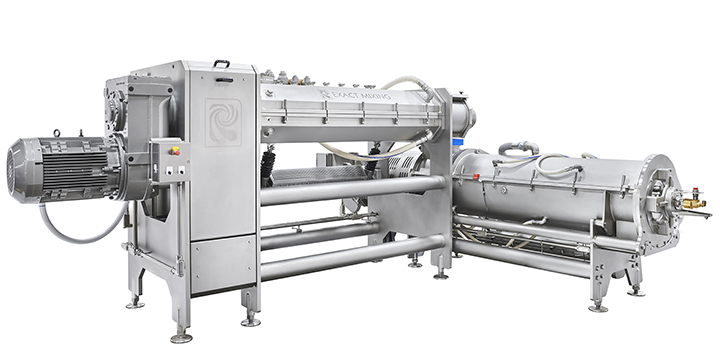
Continuous dough production is designed with volume and efficiency in mind. Requirements stemming from the product characteristics, the manufacturing needs, the facility and equipment line-up will influence how continuous mixing and kneading should be set up.
A continuous kneading and mixing process ensures all types of ingredients are mixed and kneaded in the optimum sequence to produce the desired product with consistent characteristics while saving time, resources and minimizing waste.
For the production of buns and rolls, such a system is the Exact HDX Continuous Mixer, developed by Reading Bakery Systems, which can process from 2,000 pounds per hour up to 15,000 pounds of dough per hour. It offers a number of features that make it well suited for these products:
+ The mixer has a two-stage design. In the first stage, the dough is mixed up to the clean-up stage (the point in the process where the moisture is completely distributed, but the development of the dough is only beginning). At this point, the dough will feel tacky but will not stick to the hand. The second stage is designed for the high-speed development of the dough. “Because the two units have independent drives, the two stages can be mixed at different mixing intensities. This makes the HDX Mixer very versatile,” highlights Jim Warren, vice president of Exact Mixing at Reading Bakery Systems.
+ Both stages are designed to optimize the ability to cool the dough. Highly-developed doughs such as those typically used for buns and rolls can sometimes require temperatures lower than 70°F for mixing. To control the temperature, all internal surfaces are suitable for glycol solution cooling: “The glycol (or chilled water) circulates in the mixer jacket and within the mixing shafts. The actual temperature is adjusted by either adjusting the temperature of the glycol or by changing the rate of circulation of the glycol,” Warren illustrates.
Moreover, the characteristics of the dough have been taken into consideration in the design of the HDX Mixer. Dough with hydration ratios of 60% and higher generally requires a great deal of shear to be developed to the required level. The key to success is to apply energy in a way such that the gluten strands are formed without shearing or shortening the strands, which is what the HDX is designed to do, he explains.

Exact Mixing
The company was founded in 1992 in the U.S. and became a part of Reading Bakery Systems in 2008. Between 1992 and 2008, four initial families of mixers were developed. These mixers allowed RBS to mix a wide variety of doughs from snack products, sweet goods, pizza, cookies and crackers to batters, and flat breads.
In 2012, RBS joined AMF as part of the Markel Food Group. AMF specializes in the production of bread and bun equipment. This led to the development of the HDX Mixers, a fifth mixer family, which are specifically designed for these types of high development doughs.
Buns and rolls with the HDX Mixer
The equipment from Exact Mixing streamlines necessary processes for efficiency. The workflow is synchronized so that the dough is made at the same rate it is used, to avoid the accumulation of large batches of doughs that would need to be stored. Also, the dough exits from the mixer at a rate that allows it to be moved directly to the divider on a belt, without the need for resizing equipment or a dough pump.
All these processes are automatically synchronized so that a single operator is needed to oversee mixing and forming. To optimize the HDX Mixer’s settings, the primary adjustment will be in the speed of the mixer and developer shafts. “From recipe to recipe, the process may require more or less development or mixing due to specific requirements,” Warren explains. Other potential adjustments can include temperature settings, the location of the ingredient infeed, and controlling the quantity of the product in the mixer.
To control the temperature of the finished dough, the equipment offers three possibilities: coolant system adjustments, controlling the ingredient temperatures and the speed of the developer shaft (the last method is used less than the other two, because the manufacturer may not want to change the product’s development level). “The coolant properties can be easily automated, and it is the most common method used to control the finished dough temperature. This can be done best by adjusting the rate of coolant dough through the mixer jacket,” the specialist illustrates. Dough hydration is controlled by balancing the amount of moisture added to the dough and the speed of the mixer and development shafts.
Processes are automated to guarantee consistency; all process variables, including individual ingredient input rates, temperatures, development levels, and other inputs are constantly measured, compared to set points and automatically adjusted to assure the dough leaving the mixer meets set requirements consistently. In addition, the downstream equipment and dividing hopper levels are monitored and the mixer output automatically adjusted to match the rate needed.
For process safety, parts in motion are completely enclosed, and operations can be managed remotely. Food safety is also guaranteed since the dough is never exposed to the
environment.


